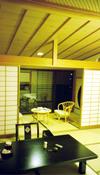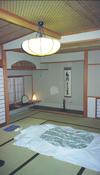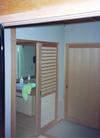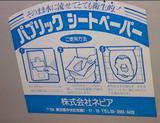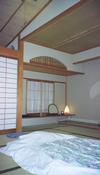

Of course, you leave your shoes at the front desk when you check in. But better yet, you leave the rest of your clothes behind immediately upon getting to your room, and change into a fresh cotton yukata provided by the inn.For the rest of your stay, it will be your primary clothing (along with the Japanese split-toe socks also provided). There are geta (Japanese wooden sandals) at all of the door leading out into the gardens or the town for your use as well.
And then comes dinner. Your dinner is served to you in your room by a kimono-clad young woman who takes care of no more than a few rooms of the inn. It consisted of about twenty-four dishes that came in three waves -- I think it might come in four or five if I had arrived earlier -- served in your room. The food was amazing, definitely the finest meal I had in Japan on this trip. Every kind of Japanese cuisine was represented -- sashimi, tempura, a hot stew dish -- all arranged to the utmost aesthetic and culinary standards.
In fact, at the ryokan I underwent a religious tempura experience! I had never liked tempura, since my exposure to it in America had made me conclude it was a form of batter-fried southern food with shrimp instead of chicken inside. The tempura at o-nishisuishooen changed my attitude! Unbelievably light and with no lingering greasiness at all, it showed me why tempura became famous in the first place! Later in my trip, my friend Scott took us to his favorite tempura restaurant near Mitaka, and proved that the experience here was no fluke -- well-made Japanese tempura is indeed a delight. I have yet to find anywhere in America that reaches that level of tempura.
However, the one caveat about staying at a ryokan -- at least at one in Kinosaki -- is this: they don't speak English. My room attendant spoke almost no English, and the desk personnel spoke only a little more. Kinosaki was the first place I had been to where my terrible Japanese was actually much better than my conversation partners' English. However, my Japanese wasn't up to the task of answering questions phrased in the extremely polite (PL4, for you Mangajin readers out there) Japanese that was used at the ryokan. It's really necessary to speak Japanese -- or be in the company of someone who does -- to come here! I just barely made it out without (I think) embarrassing myself!
